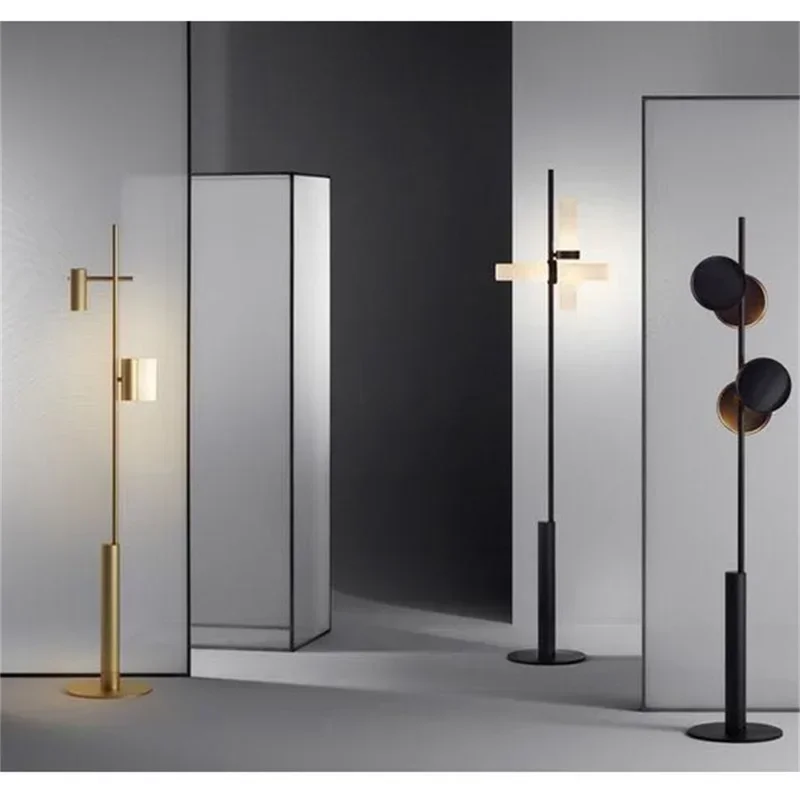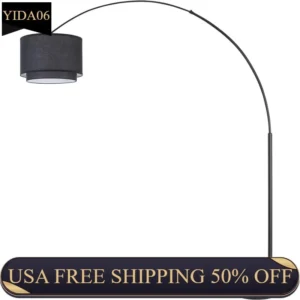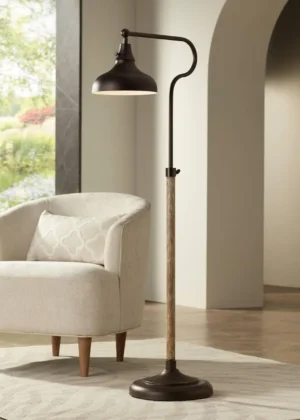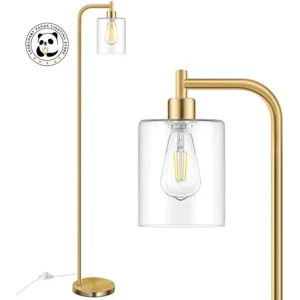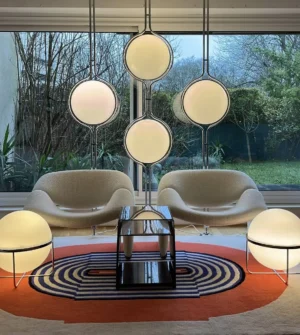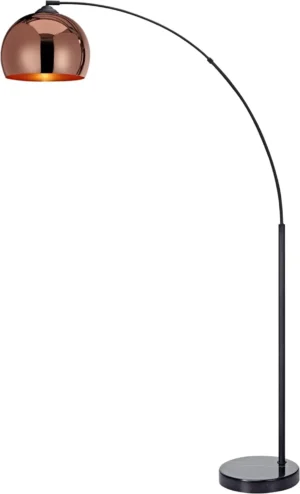Introduction: The Dramatic Impact of Modern Arc Lighting in Contemporary Living Rooms
An arc floor lamp is not just a light source—it’s a statement piece that can transform your living room from ordinary to extraordinary. With their distinctive curved arm extending from a weighted base and suspended shade, arc lamps command attention while providing both form and function to your space.
These elegant lighting fixtures have evolved from their mid-century origins to become essential elements in contemporary interior design. What makes arc floor lamps so appealing is their unique ability to serve dual purposes—they provide directed illumination exactly where you need it while simultaneously acting as sculptural art pieces that enhance your décor.
The dramatic silhouette of a modern arc lamp creates visual interest in any living space. As overhead lighting continues to fall out of favor among interior designers, floor lamps—particularly statement arc lamps—have seen a significant rise in popularity, with design publications reporting a 40% increase in their use in contemporary homes over traditional lighting options.
In this comprehensive guide, you’ll discover everything you need to know about choosing your perfect arc floor lamp for your living room. From understanding key components and features to selecting the right size and style for your space, we’ll illuminate the path to finding an arc lamp that beautifully complements your home while meeting your practical lighting needs.
Understanding Modern Arc Floor Lamp Anatomy and Functionality
Before selecting the perfect arc lamp for your living room, it’s important to understand the key components that make up these distinctive fixtures. A comprehensive modern arc floor lamp guide breaks down each element and its contribution to both form and function.
The Base
The foundation of any arc lamp is its base, which provides crucial stability:
- Marble: Offers substantial weight (15-25 pounds or 6.8-11.3 kg) with elegant veining and color variations
- Metal: Provides sleek aesthetics with weighted interior components
- Concrete: Delivers industrial appeal with excellent stability
- Wood: Adds warmth and natural texture while incorporating hidden weights
The base’s width typically ranges from 10-16 inches (25-41 cm), with heavier materials allowing for narrower footprints.
The Arched Arm
The defining feature of these lamps is their graceful curved arm:
- Standard arc lamps reach heights of 60-80 inches (152-203 cm)
- Arc spans typically extend 30-45 inches (76-114 cm) from the base
- Premium models offer adjustable arcs to customize reach and height
- Materials typically include steel, aluminum, or brass tubing
The Shade
The shade determines both the light quality and visual impact:
- Dome shapes: Direct light downward for focused illumination
- Drum styles: Provide more diffused, ambient lighting
- Globe designs: Offer 360-degree light distribution
- Materials range from fabric (softer light) to metal (directed beams) to glass or acrylic (clear, bright light)
The Counterbalance System
Quality arc lamp components and features include sophisticated counterbalance systems that maintain stability despite the lamp’s extended reach. These may utilize:
- Precision-weighted bases calibrated to the arm’s extension
- Internal tension systems that distribute weight along the arm
- Adjustable mechanisms that maintain balance when repositioned
The Light Source
Modern arc lamps accommodate various bulb types housed within the shade, with significant differences in energy efficiency, light quality, and lifespan.
The technical design of arc lamps allows them to provide illumination to areas where traditional floor lamps can’t reach, making them particularly valuable for lighting seating areas away from walls.
Marble base arc floor lamps offer exceptional stability while making a luxurious design statement that complements various interior styles.
Assessing Your Living Room’s Lighting Needs Before Selection
Before investing in a modern arc floor lamp, take time to evaluate your living room’s current lighting situation. Understanding the different lighting functions will help you determine how your new lamp will fit into your overall lighting strategy.
The three primary types of lighting work together to create a well-lit, comfortable space:
Ambient Lighting: This provides overall illumination throughout the room, typically coming from ceiling fixtures, recessed lights, or multiple lamps. An arc lamp with a translucent shade can contribute significantly to ambient lighting.
Task Lighting: Focused illumination for specific activities like reading, working, or hobbies. Arc lamps excel here, as their adjustable positioning allows you to direct light exactly where needed.
Accent Lighting: Highlights architectural features, artwork, or decor elements. An arc lamp with a directional shade can double as accent lighting when strategically placed.
When assessing your space, consider which of these lighting needs are currently underserved. For rooms with ample overhead lighting but lacking task lighting for reading areas, a focused arc lamp might be ideal. Alternatively, if your space needs both general illumination and a design statement, a lamp with a larger, more diffusive shade would be appropriate.
The size of your living room also determines light output needs. As a general guideline:
– Small rooms (under 150 sq ft): 1,500-3,000 lumens total
– Medium rooms (150-250 sq ft): 3,000-4,000 lumens total
– Large rooms (over 250 sq ft): 4,000+ lumens total
Your arc lamp will contribute to this total output, working alongside other light sources to create a layered lighting effect. Creating warm lighting in your living room involves combining different light sources at various heights and intensities.
For maximum flexibility, consider dimmable arc floor lamps that allow you to adjust brightness based on time of day, activities, or mood. This adaptability makes them particularly valuable in multi-purpose living rooms.
Matching Arc Lamp Styles to Your Living Room Aesthetic
The right arc lamp should complement your living room’s existing design language. With diverse options available, you can find a style that either blends seamlessly with your current aesthetic or provides an intentional contrast as a statement piece.
Minimalist Modern
- Clean, unadorned silhouettes
- Monochromatic color schemes (black, white, brushed metals)
- Limited ornamentation with focus on form
- Often features slim profiles and geometric shapes
- Materials like brushed steel and simple fabric shades
Industrial Chic
- Raw, utilitarian materials like blackened steel or brass
- Exposed hardware and mechanical elements
- Often incorporates concrete bases or weathered finishes
- Visible joints and connections as design features
- May include vintage-inspired bulbs or cages
Mid-Century Modern
- Organic, flowing forms inspired by 1950s-1960s design
- Warm wood tones (walnut, teak) combined with metals
- Often features tapered legs on bases
- Distinctive retro-futuristic shapes
- Fabric shades in period-appropriate colors
Mid-century arc floor lamps celebrate this iconic design era with authentic details while incorporating modern functionality.
Scandinavian Simplicity
- Light woods like ash, oak, or birch
- Gentle curves and rounded forms
- Natural materials and neutral color palettes
- Emphasis on craftsmanship and functional design
- Often includes fabric elements in muted tones
Contemporary Luxe
- Bold, dramatic proportions with striking silhouettes
- Mixed metals (often polished) with luxurious finishes
- Statement marble or stone bases
- Sophisticated materials like smoked glass or premium fabrics
- Often incorporates unexpected design elements
Contemporary arc floor lamps offer modern sophistication with clean lines and innovative materials that elevate your living space.
Transitional Designs
- Blends traditional elements with contemporary forms
- Balanced proportions that neither overwhelm nor underwhelm
- Mixed material approach (metal with wood or fabric)
- Neutral colors with occasional accent finishes
- Familiar shapes reinterpreted in fresh ways
When selecting a style, consider not just your current furniture but also the architectural elements of your room. A minimalist lamp may complement ornate traditional furniture by providing visual relief, while a statement piece can add personality to more understated décor.
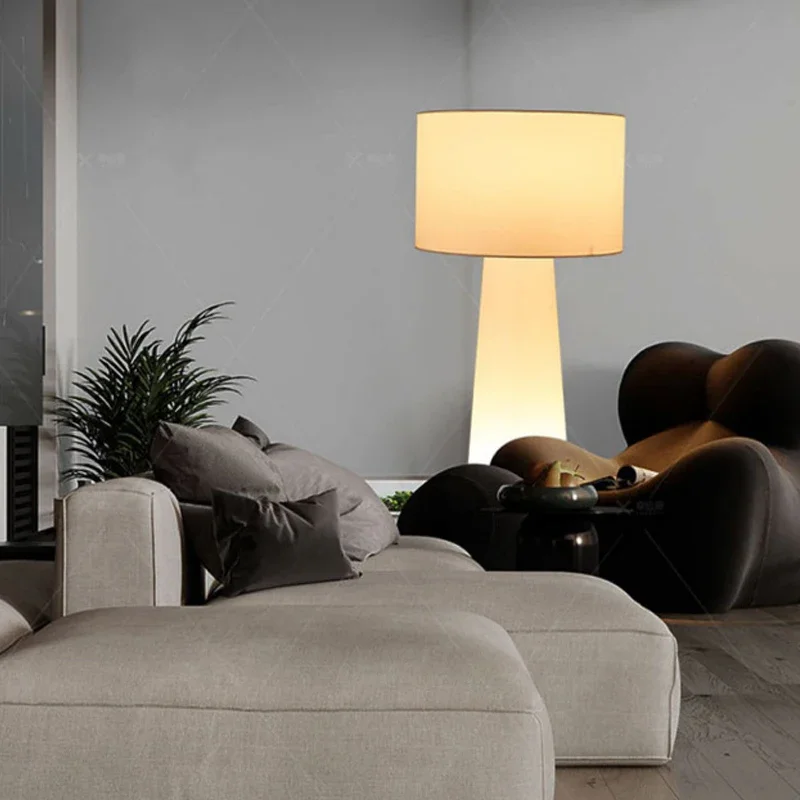
Determining the Ideal Size and Scale for Your Space
Finding the perfect arc floor lamp requires careful consideration of your room’s dimensions to ensure proper scale and proportion. A lamp that’s too small may look insignificant, while one that’s too large can overwhelm your space.
Ceiling Height Considerations
The standard height for arc floor lamps ranges from 60-80 inches (152-203 cm), but your ceiling height should guide your selection:
- 8-foot ceilings (2.4 m): Choose lamps under 70 inches (178 cm) tall
- 9-foot ceilings (2.7 m): Lamps up to 75 inches (190 cm) work well
- 10+ foot ceilings (3+ m): Consider taller lamps up to 80+ inches (203+ cm)
Always maintain a minimum clearance of 18-24 inches (45-61 cm) between the bottom of the shade and the surface below it—whether that’s a sofa, chair, or floor.
Arc Span and Room Size
The horizontal reach of your arc lamp should be proportional to both your room dimensions and the furniture it will illuminate:
- Small rooms (under 150 sq ft): Choose arcs with 30-36 inch (76-91 cm) reach
- Medium rooms (150-250 sq ft): Arcs spanning 36-42 inches (91-107 cm) work well
- Large rooms (over 250 sq ft): Consider large oversized arc floor lamps with reaches of 42-60+ inches (107-152+ cm)
Calculating Ideal Dimensions
For optimal proportions, a simple formula can help:
- Measure the furniture the lamp will accompany (sofa, reading chair, etc.)
- The lamp’s height should be approximately 1.5 times the furniture height
- The arc’s reach should extend about ⅔ to ¾ across the furniture piece
For example, a 30-inch tall armchair would pair well with a lamp that’s about 45 inches tall, with an arc extending 20-25 inches horizontally.
Understanding the perfect arc floor lamp height for your specific space will ensure both visual harmony and practical functionality.
Visual Weight Considerations
Beyond actual dimensions, consider the lamp’s “visual weight”—how substantial it appears:
- Large rooms can accommodate visually heavier lamps with substantial bases and thick arches
- Smaller spaces benefit from visually lighter designs with slimmer profiles and transparent or smaller shades
- In open-concept rooms, larger lamps help define separate functional areas
Remember that the empty space created by an arc lamp’s curve is part of its design presence—ensure your room has sufficient visual space to showcase this distinctive silhouette.
Material Selection for Durability and Design Harmony
The materials used in your arc floor lamp affect not only its appearance but also its durability, stability, and how it integrates with your existing décor. Making informed material choices ensures your lamp will remain both beautiful and functional for years.
Base Materials
Marble: Offers excellent stability with sophisticated visual appeal. The natural veining patterns make each piece unique, while the substantial weight (often 15-25 pounds) provides a solid foundation. Available in white, black, and various colored varieties.
Metal: Steel, aluminum, and cast iron bases provide clean, contemporary profiles. Often includes additional hidden weights for stability. Finishes range from polished chrome to brushed nickel to powder-coated colors.
Concrete: Delivers industrial chic appeal with substantial weight and a raw, textural quality. Modern concrete formulations can include polymers for enhanced durability and reduced weight.
Wood: Wood arc floor lamps bring warmth and organic elements to contemporary designs. Often paired with metal elements, wood bases typically incorporate hidden weights to ensure stability.
Arm Materials
Steel: Provides excellent strength with a relatively slim profile, allowing for dramatic arcs without excessive visual weight.
Aluminum: Lighter than steel but still strong, aluminum offers sleek lines and is naturally corrosion-resistant.
Brass: Adds warmth and sophistication with its golden tones. Available in polished, brushed, or antiqued finishes.
Shade Materials
Fabric: Creates a soft, diffused light ideal for ambient illumination. Available in various opacities and colors to suit your design scheme.
Metal: Directs light downward for focused illumination. Can range from sleek, minimalist designs to perforated patterns that create interesting light play.
Glass or Acrylic: Offers clear, bright illumination with a contemporary look. Glass adds weight at the end of the arc, requiring more robust counterbalancing.
Finish Considerations
The finish of your lamp affects both its visual integration with your space and its maintenance requirements:
- Brushed finishes: Hide fingerprints and minor scratches better than polished surfaces
- Powder-coated colors: Offer excellent durability and color fastness
- Natural materials: May patina over time, developing character with age
- Mixed materials: Create visual interest but require different cleaning methods
When selecting materials, consider not just their appearance but their practical implications. Marble requires periodic sealing, fabric shades collect dust, and polished metals show fingerprints. Choose materials that match your tolerance for maintenance while complementing your existing furniture finishes.
Essential Functionality Features to Consider
Beyond aesthetics, the functional aspects of your arc floor lamp will determine how well it serves your daily needs. These practical features can make the difference between a lamp that’s merely decorative and one that becomes an indispensable part of your living space.
Adjustability Options
Adjustable arc floor lamps offer versatility that standard fixed designs can’t match:
- Height adjustment: Telescoping poles or movable joints that allow you to raise or lower the overall height
- Arm articulation: Joints that let you change the reach and angle of the arc
- Swivel capability: Bases that rotate to redirect the arc without moving the entire lamp
- Adjustable heads: Shades that tilt or rotate to direct light precisely where needed
Advanced models may combine multiple adjustment types, creating nearly infinite positioning options.
Dimming Capabilities
Light intensity control is essential for creating different moods and accommodating various activities:
- Built-in dimmers: Physical dials or touch-sensitive controls integrated into the lamp
- Foot dimmers: Floor switches that allow hands-free operation
- Compatibility with smart dimmers: Circuitry that works with external dimming systems
- Multi-level switching: Separate controls for different bulbs within the same fixture
When selecting a lamp with dimming features, ensure it’s compatible with your chosen bulb type—not all LEDs work with traditional dimmers.
Stability Mechanisms
A well-designed arc lamp incorporates features that prevent tipping despite its extended reach:
- Weighted bases: Substantial counterweights (often hidden) in the base
- Low center of gravity: Weight distribution that maximizes stability
- Extended base footprints: Wider bases that provide greater stability
- Anti-tip features: Safety mechanisms that increase resistance to accidental knocking
Control Systems
Consider how you’ll interact with your lamp on a daily basis:
- Touch controls: Modern, streamlined operation without physical switches
- Foot switches: Convenient operation without bending down
- Remote controls: Operation from across the room
- Smart home integration: Voice control through systems like Alexa or Google Home
Contemporary Arc Floor Lamp, Large Arc Floor Lamp, Oversized Arched Floor Lamp
$460.63 Select options This product has multiple variants. The options may be chosen on the product pageAdjustable Arc Floor Lamp, Bronze Arc Floor Lamp
Price range: $440.95 through $558.52 Select options This product has multiple variants. The options may be chosen on the product pageBrass Arc Floor Lamp, Contemporary Arc Floor Lamp, LED Arc Floor Lamp
Price range: $490.72 through $522.04 Select options This product has multiple variants. The options may be chosen on the product pageChrome Arc Floor Lamp, LED Arc Floor Lamp
Price range: $304.95 through $1,210.40 Select options This product has multiple variants. The options may be chosen on the product pageContemporary Arc Floor Lamp, Large Arc Floor Lamp, Marble Base Arc Floor Lamp
$224.94 Select options This product has multiple variants. The options may be chosen on the product pageMid-Century Arc Floor Lamp, Wood Arc Floor Lamp
$230.86 Select options This product has multiple variants. The options may be chosen on the product page
Energy Efficiency
Modern arc lamps increasingly prioritize energy-saving features:
- LED compatibility: Fixtures designed specifically for energy-efficient bulbs
- Integrated LEDs: Built-in lighting elements that eliminate the need for replaceable bulbs
- Energy Star certification: Validation of efficiency standards
- Low-voltage options: Reduced power consumption without sacrificing brightness
When evaluating functionality features, prioritize those that align with your specific needs and usage patterns. A reading lamp benefits most from adjustability, while ambient lighting might prioritize dimming capabilities.
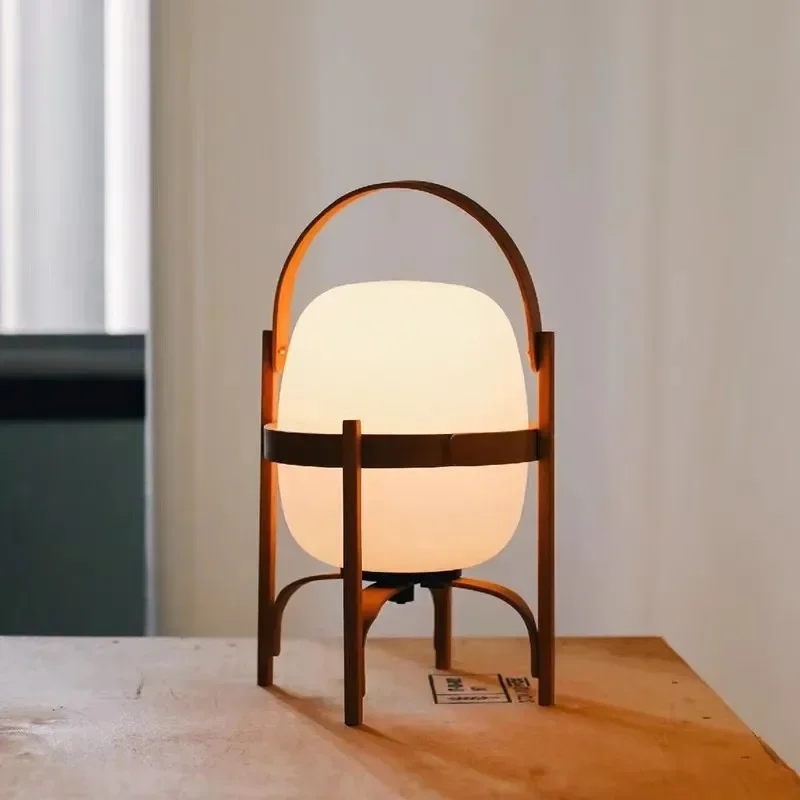
Understanding Light Quality and Bulb Selection
The type of light your arc lamp produces significantly impacts both the functionality of your space and the mood it creates. Selecting the right bulb involves understanding several key lighting characteristics.
Bulb Types
Modern arc lamps typically accommodate one of these bulb varieties:
LED (Light Emitting Diode): The current standard for energy efficiency and longevity. LED arc floor lamps use up to 80% less energy than incandescent options while lasting 15-25 times longer (25,000-50,000 hours). They produce minimal heat and come in various color temperatures.
Halogen: Produces a bright, white light that most closely resembles natural sunlight. More energy-efficient than incandescent bulbs but less so than LEDs. Typical lifespan ranges from 2,000-4,000 hours.
Incandescent: Traditional bulbs with warm light but poor energy efficiency. While becoming less common, some arc lamps still accommodate these familiar bulbs with their characteristic warm glow.
Color Temperature
The “warmth” or “coolness” of light is measured in Kelvins (K):
Warm White (2700K-3000K): Creates a cozy, inviting atmosphere similar to traditional incandescent lighting. Ideal for living rooms where relaxation is the primary goal.
Neutral White (3500K-4100K): Balanced light that’s neither notably warm nor cool. Good for multipurpose living spaces.
Cool White (5000K+): Crisp, energizing light similar to daylight. Generally too stark for living rooms but may work in contemporary, minimalist spaces.
Most interior designers recommend warm white lighting for living areas to create an inviting ambiance that enhances skin tones and makes the space feel more comfortable.
Brightness Levels
Brightness is measured in lumens rather than watts (which only measure energy consumption):
- Ambient living room lighting: 1,500-3,000 lumens total
- Reading light: 400-700 lumens directed to the task area
- Accent lighting: 200-400 lumens to highlight features
A typical arc floor lamp should provide between 800-2,000 lumens depending on whether it’s serving as primary or supplementary lighting.
Light Direction Considerations
The shade design affects how light is distributed:
- Downward-directed: Ideal for reading or task-focused activities
- Diffused: Better for general ambient lighting
- Adjustable: Provides the most flexibility for different needs
Replacement and Longevity
Consider the long-term maintenance of your lighting choice:
- Integrated LEDs: Cannot be replaced but typically last 15-20 years
- Replaceable bulbs: Allow for changing bulb types or updating as technology improves
- Availability: Some specialty bulbs may become harder to find over time
Selecting the right light source ensures your arc lamp not only looks beautiful but also provides the appropriate illumination for your specific needs while creating warm lighting in your living room.
Strategic Placement for Maximum Impact and Functionality
Where you position your arc floor lamp significantly affects both its visual impact and lighting effectiveness. Strategic placement transforms this fixture from merely decorative to genuinely functional.
Over Seating Areas
One of the most popular and practical placements for arc floor lamps is over seating:
Reading chairs: Position the base 20-30 inches (51-76 cm) to the side of the chair with the arc extending over the seating area. The bottom of the shade should be 55-65 inches (140-165 cm) from the floor, creating optimal positioning for reading.
Sofa arrangements: Place the lamp at either end of a sofa with the arc extending toward the center, providing light across the seating area. For sectionals, position near the junction point to illuminate multiple seating sections.
Conversational groupings: Center the lamp over a coffee table surrounded by seating, creating a focal point that anchors the conversation area.
Corner Placement
Utilizing corners effectively maximizes floor space while adding visual interest:
- Position the lamp base in an unused corner with the arc extending into the room
- This arrangement works particularly well in smaller living rooms
- The curve of the arc softens the angular corner while drawing the eye upward
Behind Sofas
For living rooms where sofas float in the room rather than against walls:
- Place the arc lamp behind the sofa with the arm extending over the seating area
- This arrangement eliminates the need for end tables and table lamps
- Keep the base at least 6-8 inches (15-20 cm) behind the sofa to prevent accidental tipping
Defining Areas in Open Layouts
Modern arc lamps excel at creating visual boundaries in open-concept spaces:
- Use the lamp to delineate between living and dining areas
- Create a reading nook within a larger room
- Establish a conversation zone separate from entertainment areas
Clearance Guidelines
For both safety and visual appeal, maintain proper clearances:
- Minimum 7 feet (2.1 m) ceiling clearance for standard arc lamps
- At least 18 inches (45 cm) between shade bottom and head height when seated
- Allow 24-30 inches (61-76 cm) of walking space around the lamp base
- Position at least 24 inches (61 cm) from curtains or wall hangings
Furniture Pairing
Certain furniture combinations particularly complement arc floor lamps:
- Armless sofas or low-profile seating that doesn’t visually compete with the lamp’s silhouette
- Side tables that nestle partially under the arc, creating layered dimensions
- Ottomans or poufs that can be pulled under the light for temporary task lighting
Remember that an arc lamp creates visual weight in a room—balance this by ensuring adequate open space around the fixture to showcase its distinctive curve.
Harmonizing Your Arc Lamp with Existing Decor Elements
Integrating a statement piece like a modern arc floor lamp requires thoughtful consideration of your existing décor. When done successfully, your new lamp will feel like it was always meant to be part of your living room’s design story.
Coordinating with Other Lighting Fixtures
Create a cohesive lighting scheme by considering how your arc lamp relates to other light sources:
- Maintain a consistent design language across fixtures (industrial, minimalist, etc.)
- Limit material finishes to 2-3 types throughout the room (brass, nickel, black, etc.)
- Consider complementary rather than matching pieces for a curated rather than formulaic look
- Balance fixture scales—pair substantial arc lamps with more delicate table lamps
Material Harmony
Connect your arc lamp to existing furniture through thoughtful material coordination:
- Echo the lamp’s base material in coffee tables, side tables, or decorative objects
- Match metal finishes with existing hardware, furniture legs, or picture frames
- If introducing a new material, ensure it appears at least three times throughout the room to create rhythm and intentionality
- For mixed-material lamps, emphasize the material that best connects to your existing décor
Color Integration
Use color to create a seamless connection between your lamp and room palette:
- For neutral interiors, match the lamp’s finish to existing neutral tones
- In colorful spaces, either match a dominant accent color or choose a neutral that allows other colors to shine
- Consider lamp shades that complement wall colors or soft furnishings
- Remember that metal finishes like brass and copper read as colors in design schemes
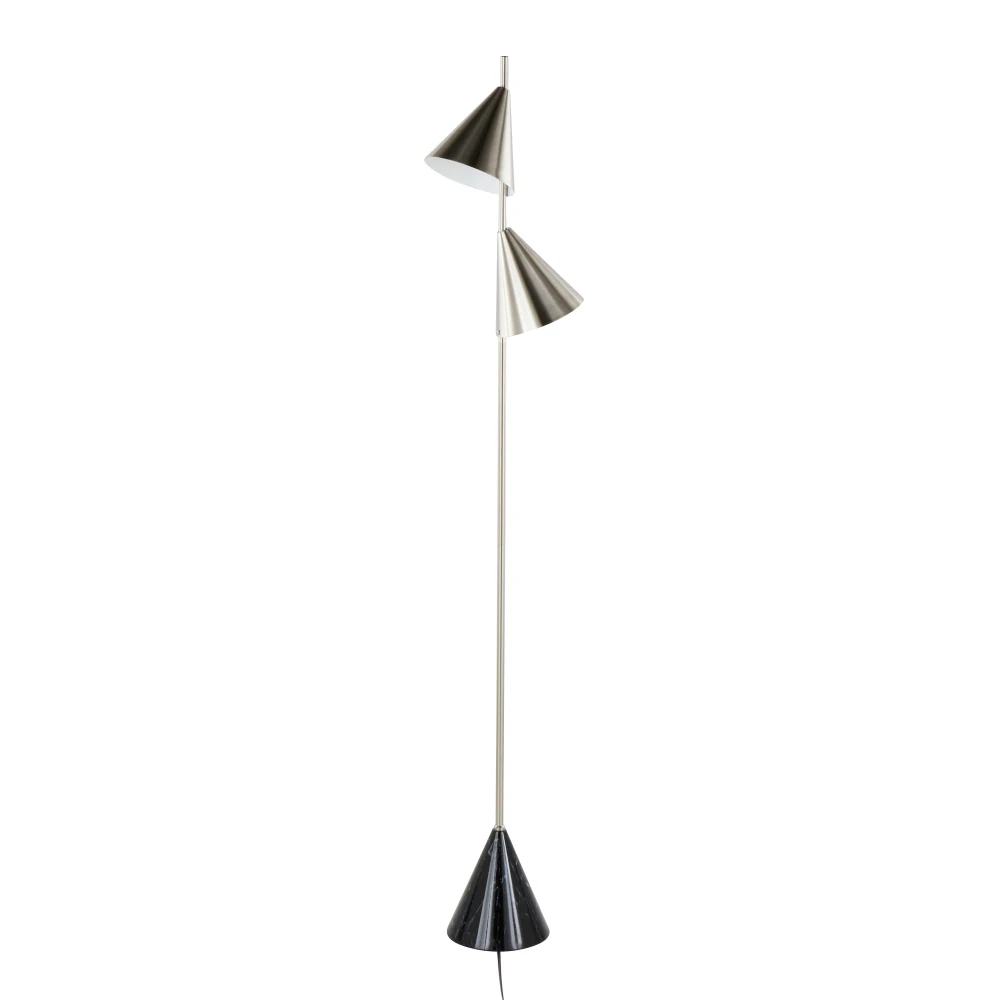
Creating Visual Balance
Ensure your arc lamp contributes to the room’s overall equilibrium:
- Balance the lamp’s visual weight with substantial pieces on the opposite side of the room
- Create triangulation of similar elements (repeat metallic finishes or shapes in three locations)
- Consider the negative space created by the arc as part of your design composition
- Use the lamp’s curve to soften angular furniture arrangements or add fluidity to rigid layouts
Scale Relationships
Maintain appropriate proportional relationships between your lamp and surrounding furniture:
- The lamp’s height should generally exceed adjacent furniture by 20-30%
- The arc’s reach should relate to the width of the furniture it illuminates
- The base diameter should be proportionate to the floor space available
- The shade size should correspond to the volume of space being lit
When properly integrated, your arc floor lamp will feel like a deliberate design choice rather than an afterthought, enhancing your living room’s overall aesthetic while providing essential lighting function.
Maintaining and Caring for Your Modern Arc Floor Lamp
Proper maintenance ensures your arc floor lamp remains both beautiful and functional for years to come. Different materials require specific care approaches:
Marble Base Care
- Dust regularly with a soft, dry cloth
- Clean with a damp microfiber cloth and mild soap if needed
- Apply marble sealant annually to prevent staining
- Use coasters under drinks placed near marble bases
- Avoid acidic cleaners that can etch the surface
Metal Components
- Dust regularly with a soft cloth
- Clean chrome, nickel, or stainless steel with a specific metal cleaner
- Use a brass cleaner with a protective coating for brass elements
- Apply a thin coat of paste wax to unfinished metals to prevent oxidation
- Avoid abrasive cleaners that can scratch finishes
Fabric Shades
- Dust gently with a soft brush attachment on your vacuum
- Spot clean with mild soap and water using minimal moisture
- Replace shades that become discolored or damaged
- Keep away from direct sunlight to prevent fading
- Rotate periodically for even aging if in bright environments
Wood Elements
- Dust with a soft, dry cloth following the grain
- Apply appropriate wood polish or oil based on finish
- Keep away from heating vents and direct sunlight
- Maintain consistent humidity levels to prevent cracking
- Clean spills immediately to prevent staining
Electrical Component Maintenance
- Check cords periodically for wear or damage
- Ensure switches operate smoothly without sticking
- Replace bulbs according to manufacturer specifications
- Clean sockets and switches with power disconnected
- Have unusual noises or performance issues evaluated by a professional
Adjustment Mechanisms
- Apply a small amount of appropriate lubricant to moving parts annually
- Tighten any loose connections promptly
- Handle adjustment features gently to prevent strain
- Follow weight limitations specified by the manufacturer
- Adjust positions gradually rather than with forceful movements
With proper care, a quality arc floor lamp from Interior Ivy will maintain its appearance and functionality, continuing to enhance your living space for many years.
Avoiding Common Mistakes in Arc Lamp Selection and Placement
Even the most beautiful arc lamp can fail to meet expectations if common pitfalls aren’t avoided. Here are the most frequent mistakes people make when selecting and positioning these distinctive fixtures:
Underestimating Size Requirements
Many people choose arc lamps that are too small for their space or furniture arrangement. This diminishes both visual impact and lighting effectiveness. Solution: Measure your space carefully and select a lamp that’s proportional to both room dimensions and furniture scale.Neglecting Ceiling Height Constraints
Standard arc lamps require adequate ceiling height to achieve their distinctive curve. In rooms with ceilings under 8 feet (2.4 m), the lamp may appear cramped or require modification. Solution: Measure your ceiling height and select a lamp designed for your specific clearance.Choosing Inadequate Base Stability
The extended reach of an arc lamp requires proper counterbalancing. Lightweight bases can tip, creating both safety hazards and potential damage. Solution: Select lamps with substantial bases made from dense materials like marble or weighted metal.Overlooking Light Quality Requirements
A common error is focusing solely on style while neglecting the lamp’s primary function—providing appropriate illumination. Solution: Determine your specific lighting needs (reading, ambient, etc.) before selecting bulb type, brightness, and shade design.Creating Glare Through Improper Positioning
Arc lamps positioned incorrectly can create uncomfortable glare, particularly when the bulb is visible from seated positions. Solution: Position the lamp so the bottom of the shade is above eye level when seated, approximately 55-65 inches (140-165 cm) from the floor.Ignoring Scale Relationship with Furniture
An arc lamp that overwhelms adjacent furniture or appears diminutive beside substantial pieces creates visual discord. Solution: Match the lamp’s scale to your furniture—larger sofas require larger lamps with more dramatic arcs.Forgetting About Traffic Patterns
Placing an arc lamp in a pathway creates obstacles and increases tipping risk. Solution: Position the base away from high-traffic areas, ensuring at least 24 inches (61 cm) of clearance around the base.Mismatching Style with Room Aesthetic
An ultra-modern chrome arc lamp can look out of place in a traditional space, while an ornate design may clash with minimalist décor. Solution: Select a lamp that either complements your existing aesthetic or provides intentional contrast as a focal point.
By avoiding these common pitfalls and following the guidance in this article, you’ll find a best arc lamp for your living room that enhances both your décor and daily life.
Frequently Asked Questions About Modern Arc Floor Lamps
Can arc lamps work in small living rooms?
Yes, arc lamps can work wonderfully in smaller spaces when properly scaled. Look for compact designs with arcs spanning 30-36 inches (76-91 cm) rather than larger models. Position the lamp in a corner with the arc extending inward to maximize floor space while still enjoying the distinctive curved silhouette.
How much space should I allow around an arc lamp?
For safety and visual effect, maintain at least 24 inches (61 cm) of clearance around the base and ensure the lowest part of the shade remains at least 18 inches (45 cm) above any surface below it. Keep the lamp at least 24 inches (61 cm) from curtains, wall hangings, or other flammable materials.
Are arc lamps suitable as primary lighting sources?
Arc lamps can serve as primary lighting in smaller living rooms or intimate seating areas when equipped with appropriate bulbs (800-2000 lumens). For larger spaces, they work best as part of a comprehensive lighting plan that includes multiple sources at different heights and intensities.
What are the advantages of LED arc lamps?
LED arc lamps offer significant benefits including energy efficiency (using up to 80% less electricity), exceptional longevity (25,000-50,000 hours), reduced heat output, and availability in various color temperatures. Many also offer dimming capabilities without separate dimmer switches.
How do I prevent my arc lamp from tipping?
Select models with properly weighted bases—marble, stone, or heavy metal bases provide the best stability. Position the lamp away from high-traffic areas, secure the cord to prevent tripping, and avoid placing it where children or pets might pull or climb on it.
How do I measure to ensure proper fit in my space?
Measure your ceiling height, the furniture the lamp will illuminate, and the available floor space for the base. The ideal arc lamp should have a height approximately 1.5 times your sofa or chair height, with an arc that extends about two-thirds across the furniture piece it will illuminate.
When to Consider Professional Design Consultation
While this guide provides comprehensive information for selecting the perfect arc floor lamp, certain situations may benefit from professional expertise:
Complex Room Configurations
Consider consulting a design professional if your living room has:
– Unusual architectural features like sloped ceilings or awkward angles
– Multiple functional zones requiring integrated lighting solutions
– Historic or period-specific interiors requiring specialized knowledge
– Extremely large open concept spaces needing cohesive lighting plans
Technical Lighting Challenges
Professional lighting consultants are particularly valuable when:
– Your space has significant natural light fluctuations throughout the day
– You need specialized lighting for art collections or architectural features
– Your living room serves multiple functions requiring programmable lighting scenarios
– You’re incorporating smart home technology requiring expert integration
Investment Protection
If you’re investing in high-end lighting, professional guidance helps ensure:
– Optimal placement that showcases the fixture’s design while maximizing functionality
– Proper scale and proportion relative to your specific space and furnishings
– Coordination with existing or planned design elements
– Selection of the most appropriate technical specifications for your needs
Interior designers and lighting specialists can provide valuable insights about proportion, scale, and integration that go beyond general guidelines, helping you create a truly customized lighting solution for your unique space.
When selecting a consultant, look for professionals with specific expertise in residential lighting design rather than general interior designers, particularly if your project involves complex lighting needs or substantial investment in statement pieces.

